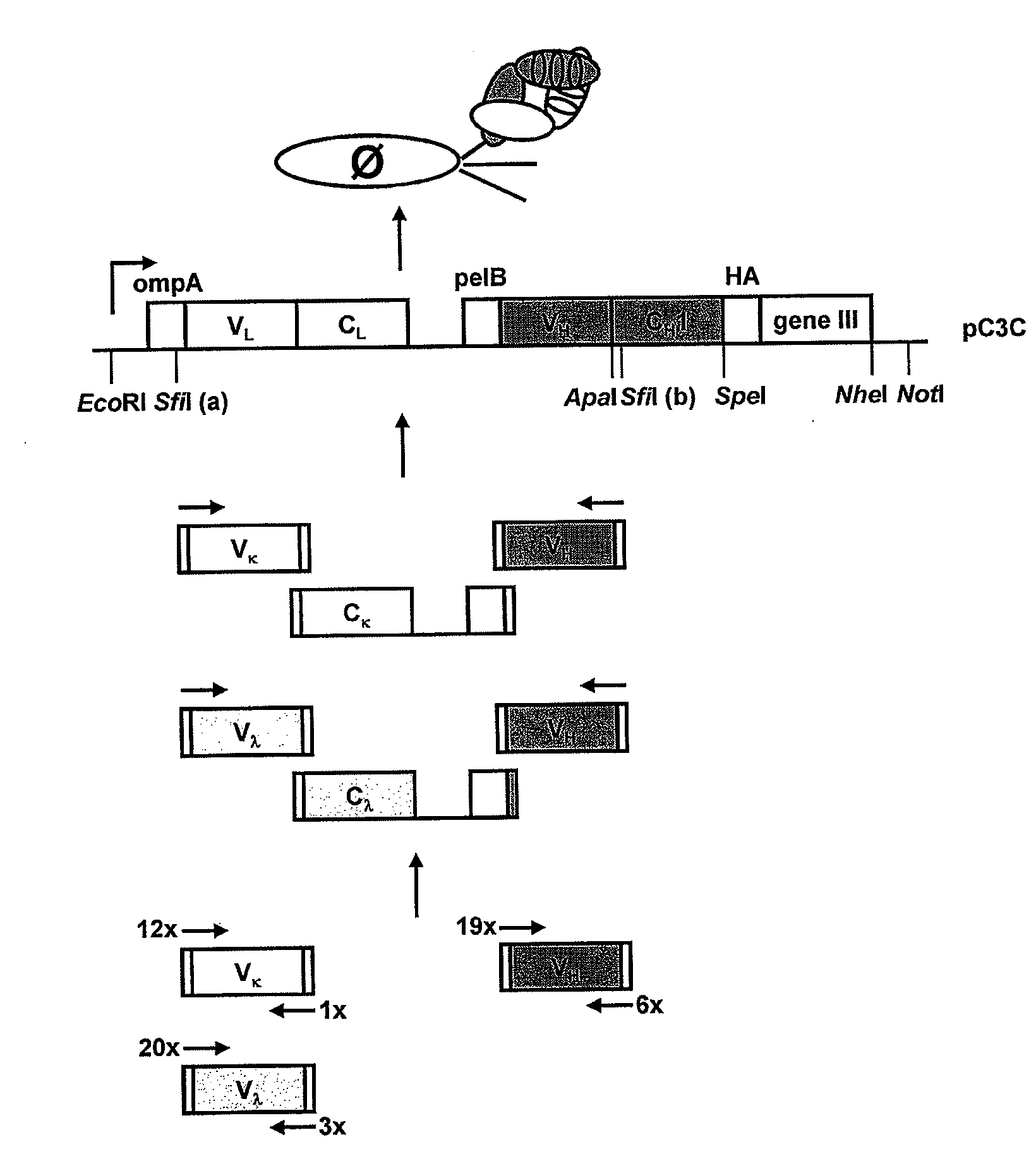Fully human Anti-human nkg2d monoclonal antibodies
- Summary
- Abstract
- Description
- Claims
- Application Information
AI Technical Summary
Benefits of technology
Problems solved by technology
Method used
Image
Examples
example 1
[0040]This example demonstrates the preparation of a human anti-human NKG2D Fab.
[0041]To obtain heavy and light chains of a human NKG2D Fab, a naïve human Fab library was prepared. For this, a naïve human Fab library in phage display vector pC3C. The design of pC3C for the generation and selection of Fab libraries with human constant domains was previously reported in Hofer et al., J. Immunol. Methods 318: 75-87 (2007).
[0042]Freshly harvested bone marrow from 6 healthy donors of diverse age, sex, and ethnicity (Poietics Human Bone Marrow; Cambrex) was separately processed for total RNA preparation and RT-PCR amplification of human Vκ, Vλ, and VH encoding sequences. To include all human germlines, a total of 61 newly designed primers in 186 different and separate combinations were used for each of the 6 healthy donors. Using established protocols as provided in Barbas et al., Phage Display: A Laboratory Manual, Cold Spring Harbor Laboratory Press, Cold Spring Harbor, N.Y. (2001), 10 ...
example 2
[0049]This example demonstrates the affinity and specificity of KYK-1.0 and KYK-2.0 Fab.
[0050]KYK-1.0, KYK-2.0, and TT11 Fab were recombinantly equipped and expressed with a C-terminal (His)6 tag using Escherichia coli expression vector pC3C-His19 and purified by immobilized metal ion affinity chromatography (IMAC). ELISA on immobilized proteins was then used as a first assessment of the specificity of purified KYK-1.0 and KYK-2.0 Fab. The following proteins were used for coating: Human Fc-NKG2D, mouse Fc-NKG2D, human CD22-Fc, human ULBP2-Fc (all from R&D Systems), human CD23 (Lab Vision Corporation), tetanus toxoid (Sanofi-Pasteur), and human Fc-ROR1 (Baskar et al., Clin. Cancer Res. 14: 396-404 (2008)). Using 100 ng of protein for coating, ELISA was carried out as described in Hofer et al., J. Immunol. Methods 318: 75-87 (2007). Goat-anti-human Fab polyclonal antibodies conjugated to horseradish peroxidase were used for detection. The absorbance at 405 nm was read before the signa...
example 3
[0061]This example demonstrates the affinity and specificity of KYK-2.0 IgG1.
[0062]For the expression of fully human KYK-1.0 IgG1λ, KYK-2.0 IgG1λ, and TT11 IgG1κ, the VH and light chain encoding sequences were PCR amplified using appropriately designed primers and cloned into mammalian expression vector PIGG as described in Hofer et al., J. Immunol. Methods 318: 75-87 (2007). Using 293fectin, 300 μg of PIGG-KYK-1.0, PIGG-KYK-2.0, or PIGG-TT11 plasmids were transiently transfected into 3×108 HEK 293F cells and kept in 300 mL FreeStyle serum-free medium in a 500-mL spinner flask on a stirring platform at 75 rpm (CELLSPIN System; Integra) in a humidified atmosphere containing 8% CO2 at 37° C. After 4 days, the medium was collected after centrifugation, replaced for an additional 3-4 days, and collected again. Pooled supernatants were then processed and purified using 1-mL recombinant Protein A or Protein G HiTrap columns (GE Healthcare) as described in Hofer et al., J. Immunol. Methods...
PUM
| Property | Measurement | Unit |
|---|---|---|
| Fraction | aaaaa | aaaaa |
| Fraction | aaaaa | aaaaa |
| Molar density | aaaaa | aaaaa |
Abstract
Description
Claims
Application Information
 Login to View More
Login to View More - R&D
- Intellectual Property
- Life Sciences
- Materials
- Tech Scout
- Unparalleled Data Quality
- Higher Quality Content
- 60% Fewer Hallucinations
Browse by: Latest US Patents, China's latest patents, Technical Efficacy Thesaurus, Application Domain, Technology Topic, Popular Technical Reports.
© 2025 PatSnap. All rights reserved.Legal|Privacy policy|Modern Slavery Act Transparency Statement|Sitemap|About US| Contact US: help@patsnap.com



